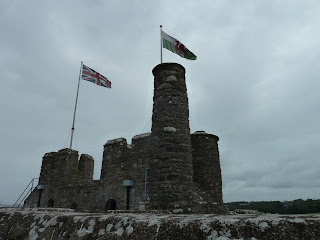De uitstap van vandaag splits ik in tweeën.
Het was overweldigend.
Allereerst Pembroke Castle: bekend omdat dit het geboortehuis is van Henry VII, de vader van de beruchte Henry VIII.
Een enorm bouwwerk. Mooi onderhouden ook.
Maar in een nietszeggende omgeving.
Deze foto geeft duidelijk het contrast weer.
Ja ja...........regen.
Pembroke Castle stands on a site that has been occupied at least since the Roman period. Roger de Montgomerie, 1st Earl of Shrewsbury founded the first castle here in the 11th century. Although only made from earth and wood, Pembroke Castle resisted several Welsh attacks and sieges over the next 30 years. The castle was established at the heart of the Norman-controlled lands of southwest Wales.[3]. Arnulf de Montgomery appointed Gerald de Windsor as his castellan at Pembroke.
When William Rufus died, Arnulf de Montgomery joined his elder brother, Robert of Bellême, in rebellion against Henry I, William's brother and successor as king; when the rebellion failed, he was forced to forfeit all his British[clarification needed] lands and titles. Henry appointed his own castellan, but when the chosen ally turned out to be incompetent, the King reappointed Gerald in 1102. By 1138 King Stephen had given Pembroke Castle to Gilbert de Clare who used it as an important base in the Norman invasion of Ireland.
In August 1189 Richard I arranged the marriage of Isabel, de Clare's granddaughter, to William Marshal who received both the castle and the title, Earl of Pembroke. He had the castle rebuilt in stone and established the great keep at the same time. Marshal was succeeded in turn by each of his five sons. His third son, Gilbert Marshal, was responsible for enlarging and further strengthening the castle between 1234 and 1241. All of Marshal's sons died childless. In 1247, the castle was inherited by William de Valence (a half-brother of Henry III), who had become Earl of Pembroke through his marriage to Joan de Munchensi, William Marshal's granddaughter.
The de Valence family held Pembroke for 70 years. During this time, the town was fortified with defensive walls, three main gates and a postern.[3] Pembroke Castle became de Valence's military base for fighting the Welsh princes during the conquest of North Wales by Edward I between 1277 and 1295. On the death of Aymer de Valence, 2nd Earl of Pembroke, William de Valence's son, the castle passed through marriage to the Hastings family. In 1389, 17-year-old John Hastingsdied in a jousting accident, ending a line of inheritance stretching back 250 years.
Pembroke Castle then reverted to Richard II. Short tenancies were then granted by The Crown for its ownership. By 1400 Owain Glyndŵr had begun a rebellion in Wales. However Pembroke escaped attack because the castle's Constable, Francis а Court, paid off Glyndŵr in gold. Then in 1452, the castle and the earldom were presented to Jasper Tudor by his half-brother Henry VI. Tudor brought his widowed sister-in-law, Margaret Beaufort, to Pembroke where in 1457 she gave birth to her only child, who was to become King Henry VII of England.
In the 15th and 16th centuries the castle was a place of peace until the outbreak of the English Civil War. Although most of South Wales sided with the King, Pembroke declared for Parliament. It was besieged by Royalist troops but was saved after Parliamentary reinforcements arrived by sea from nearby Milford Haven. Parliamentary forces then went on to capture the Royalist castles of Tenby, Haverfordwest and Carew.
In 1648, at the beginning of the Second Civil War, Pembroke's commander Colonel John Poyer led a Royalist uprising alongside Colonel Powell, Tenby Castle, and Sir Nicholas Kemoys, Chepstow Castle.[5] Oliver Cromwell came to Pembroke on 24 May 1648 and took the castle after a seven-week siege. Its three leaders were found guilty of treason and Cromwell ordered the castle to be destroyed. Townspeople were even encouraged to disassemble the fortress and re-use its stone for their own purposes.[3]
The castle was then abandoned and allowed to decay. It remained in ruins until 1880, when a three-year restoration project was undertaken. Nothing further was done until 1928, when Major-General Sir Ivor Philipps acquired the castle and began extensive restoration of the castle's walls, gatehouses and towers. After his death a trust was set up for the castle, jointly managed by the Philipps family and Pembroke town council.

























Geen opmerkingen:
Een reactie posten